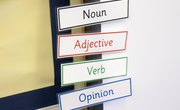A possessive noun shows ownership of a person, place, thing or idea. It is always placed before the thing being owned: Jake's shirt. The cat's tail. Susie's invention. They are used to condense sentences that show that a person owns something: Lily has blond hair that is long and tangled. Lily's blond hair is long and tangled. Although it is a simple concept, sometimes the simplest things can be the most difficult to teach to a classroom of children.
Animals
Choose an animal, such as a bear. Ask the students what the animal is like, steering the conversation to responses like "a bear has brown fur" and "a bear has sharp claws." Write these sentences down. Then ask for volunteers to "translate" these sentences to have a possessive noun: a bear's fur is brown. A bear's claws are sharp. Repeat with other animals, preferably those with distinguished features: a giraffe, an elephant, a rabbit.
Personal Property
Assign students to go home and walk through their house, writing sentences about who in their family owns different objects that they encounter. The dog's collar is yellow. Linda's dress is blue. My parents' room is bigger than Jonas' room. This activity is a good way to teach students about the different spellings of plural possessives and nouns that end with the letter "S."
Wacky Sentences
Distribute three index cards to each student. Have each of them write nouns on two of the cards and an adjective on the third. Collect the index cards, keeping the nouns and the adjectives separate, and shuffle them. Give two noun cards and one adjective card to each student. Have them take turns coming up to the board and writing out a possessive sentence using the two nouns and the adjective they were given. You should get some funny results: The dog's pants are waxy. The bird's ears are furry. Santa Claus' lamp is leathery.
Related Articles
Writer Bio
Jennifer Gigantino has been writing professionally since 2009. Her work has been published in various venues ranging from the literary magazine "Kill Author" to the rehabilitation website Soberplace. She holds a Bachelor of Arts in film and digital media from the University of California at Santa Cruz.











